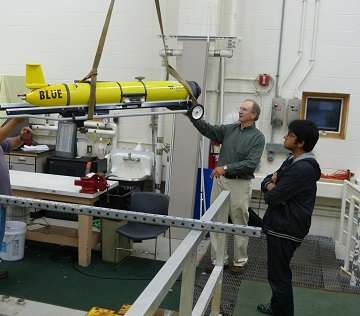Researchers launching ocean glider to study water properties in the Middle Atlantic Bight

UMass Dartmouth School for Marine Science & Technology's (SMAST) ocean glider, aptly named Blue, will begin a 500 km trip to study water properties along a triangle in in the Middle Atlantic Bight between Cape Cod to Cape Hatteras, tomorrow, October 28, 2014, at 7 a.m., from the Fairhaven Shipyard. SMAST researchers, led by Dr. Wendell Brown, will venture from the Shipyard aboard the Lucky Lady with glider Blue, which is part of a 'Glider Palooza' fleet being deployed by the Mid Atlantic Regional Association Ocean Observing System (MARACOOS). The gliders' mission is to gather data on the coastal ocean environment so scientists can better understand the dynamics that affect ocean habitats.
The ocean glider is a 1.5 meter long cylindrical hull that contains a battery-powered, computer-controlled system to operate at sea while making a whole variety of independent ocean property measurements. These particular gliders are able to travel 500-600 km in 24 to 28 days. Typically they are programmed to surface every 3 hours at which time they obtain a GPS fix and transmit scientific and engineering data to Dr. Brown and SMAST to process and do preliminary analysis of the data.
The specific mission of Blue is to measure the features of the Mid-Atlantic Cold Pool, which forms in late May, when the ocean surface warms and freshens, isolating the previous winter's cold water near the bottom-trapped Mid-Atlantic between Cape Cod to Cape Hatteras. The goal of Blue and the entire fleet is to detect and track oceanic features (i.e. upwelling events, red-tides, and coastal eddies) from their formation to dissipation, improving current understanding of the nature of coastal ecosystems, such as the Cold Pool, and providing earlier detection of oceanic features that develop offshore and into coastal waters.
The glider missions will be guided by the MARACOOS Glider Technical Center - a network including a central node at Rutgers University and secondary nodes at UMass Dartmouth, University of Delaware, and University of Maryland—Horn Point.
When recovered, Blue, along with the other gliders part of Glider Palooza 2014, will have assembled an amazing mass of evidence to the benefit of the Mid Atlantic continental shelf ecosystem and the fishing industry.
Provided by University of Massachusetts Dartmouth



















